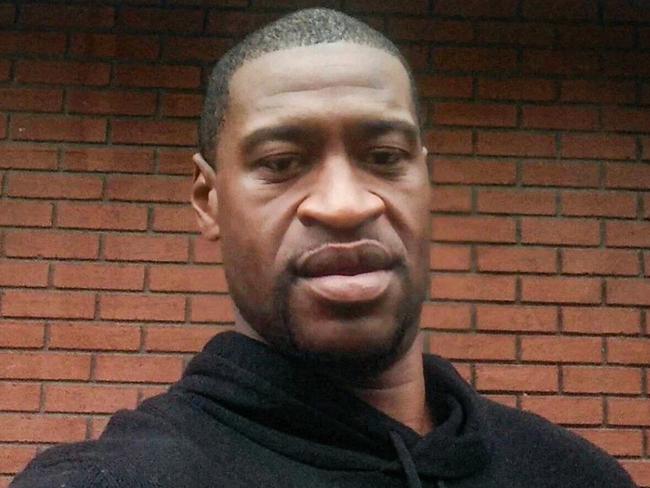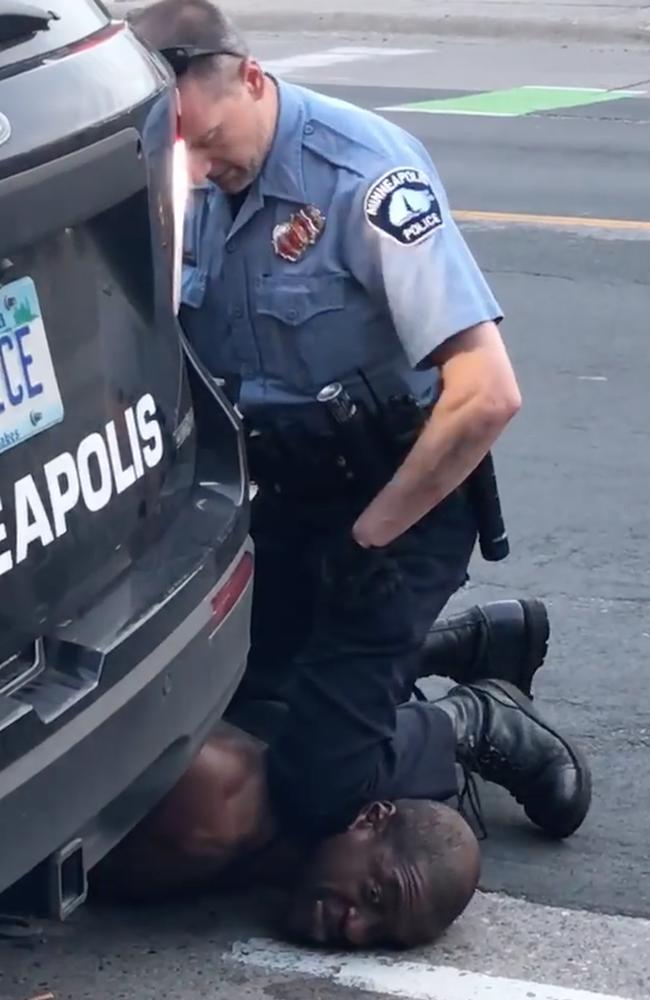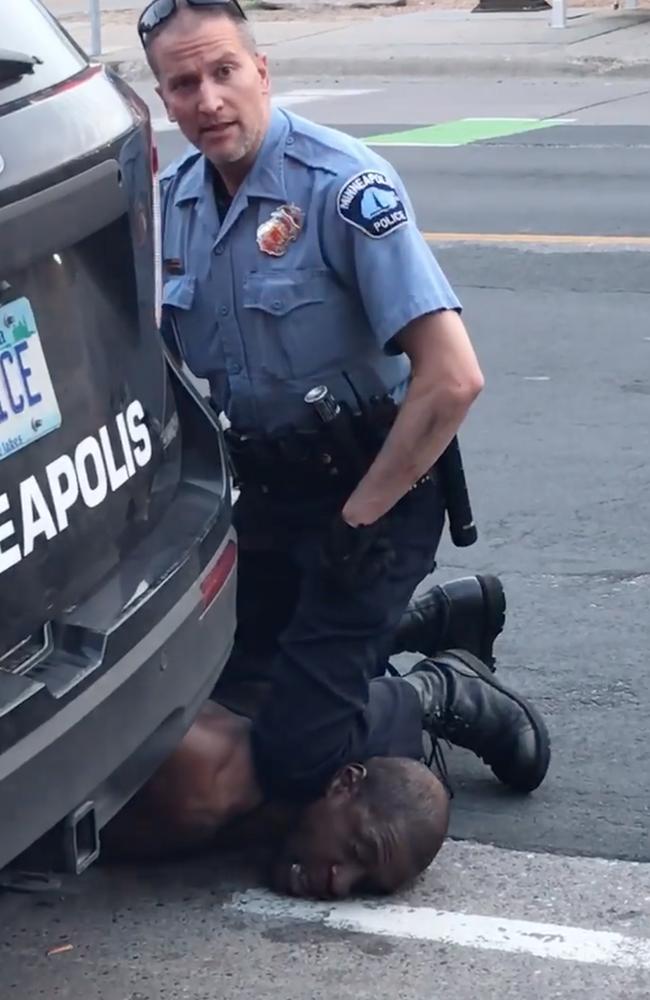Eight minutes 46 seconds: Video recreation of George Floyd’s final moments
What started with a packet of cigarettes purchased with a suspected fake $20 note led to graphic footage of a death in custody and protest around the world. Here’s the breakdown of George Floyd’s final eight minutes and 46 seconds.
World
Don't miss out on the headlines from World. Followed categories will be added to My News.
It’s the death in police custody that has shocked the world and ignited the worst US race riots in decades.
By combining videos from bystanders and security cameras, News Corp Australia has reconstructed the critical moments that led up to the horrific death of unarmed black man George Floyd.
EIGHT MINUTES AND 46 SECONDS
On Monday, May 25th, shortly before 8pm, 46-year-old security guard George Floyd walks into a convenience store in Minneapolis and buys a packet of cigarettes.
Suspecting him of using a counterfeit $20 note, two of the deli employees follow Floyd to his car across the road to confront him.

They ask Floyd, who is sitting in his car with a friend, to give them back the cigarettes, but he declines and the employees return to the store.
Four minutes later, an employee calls 911 to report the alleged fraudulent transaction.
They say that Floyd had used fake bills to buy the cigarettes and describe him as “awfully drunk and not in control of himself”.
Within minutes a police car arrives on the scene and officers Thomas Lane and J.A. Kueng approach Floyd’s car.
Lane draws his gun and orders Floyd to put his hands on the wheel.
About 90 seconds later, after reholstering his gun, he pulls Floyd from the car.
The officers order Floyd to put his hands behind his back, handcuff him and walk him to the front of the restaurant next to where the car is parked.
Floyd is made to sit on the ground with his back to the wall.
Six minutes later, the officers take Floyd back to their police vehicle parked across the intersection next to the deli.
Footage shows Floyd falling to the ground in front of the police car’s open front door.

According to the criminal complaint filed against officer Derek Chauvin, the officer charged with murder, Floyd told the police he did not want to get in their car because he was claustrophobic.
There is a struggle, and according to the complaint Floyd turned his head to the officers several times to tell them that he couldn’t breathe.
Nine minutes after Floyd is arrested, a third police car arrives on the scene.
It is carrying officers Tou Thao and Derek Chauvin, who have had six and 17 complaints, respectively, filed against them in the past.
While Kueng is struggling with Floyd in the backseat, Chauvin goes to the other side of the car and pulls Floyd from the backseat onto the ground.
Floyd is now lying facedown in the street.
Two witnesses start filming the incident at this point.
Three officers kneel on Floyd’s body to pin him down while officer Thao watches on.
PLEASE, I CAN’T BREATHE
Floyd starts to cry out saying, “Please, I can’t breathe.”
One of the bystanders filming the incident is instructed to cross to the other side of the street.
The officers call for code 2 non-emergency medical assistance, reporting “bleeding to the mouth” [referring to Floyd].
Soon afterwards, the call is upgraded to code 3, requesting emergency medical assistance.
Another bystander starts filming the incident.
She captures Chauvin kneeling on Floyd’s neck for another seven minutes after emergency medical assistance had been called.
One of the officers says to Floyd, with exasperation, “What do you want?!”
Floyd replies, “I can’t breathe. Please, the knee in my neck, I can’t breathe!”
“Well then, get up and get in the car, man!” one officer says.
“I can’t move!” says Floyd.
Chauvin still has his knee pressed down on Floyd’s neck.
He says, “Mama, mama,” while the officer continues to tell him to get up and get in the car. Chauvin’s knee is still pinning Floyd down and over the next five minutes, he says, “I can’t breathe” at least 16 times.
Floyd’s eyes close as he appears to lose consciousness.
Bystanders start to yell at the police to let him up.

Thao stands in front of Chauvin and Floyd with his hands on his hips.
One bystander says, “he’s got mace,” apparently referring to one of the officers.
“Bro, he’s not f_king moving!” A bystander yells.
“Did they f_king kill him, bro?” asks another.
The conscious neck restraint movement, as it is formally known, is only intended to be used on suspects who are “actively moving”, according to Minneapolis Police Department policy.
According to the complaint against Chauvin, Lane asks him twice if Floyd should be rolled onto his side, and Chauvin says no both times.
Twenty minutes after Floyd is arrested, an ambulance arrives and even as the paramedic is trying to take Mr Floyd’s pulse, Chauvin’s knee is still on his neck.
He only gets up when the paramedic tells him to. at which point Chauvin’s knee has been pinning down Floyd’s neck for nearly eight minutes and 46 seconds.
Floyd, clearly unconscious, is loaded onto the stretcher and into the ambulance, which then leaves the scene.
The paramedics call for additional help from the fire department, who arrive outside the deli, but are not given any “clear info on Mr Floyd or his whereabouts” by police, according to reports.
Meanwhile, Floyd is going into cardiac arrest in the ambulance.
It takes the fire engine five minutes to reach the ambulance and a short while later, at 9:25pm, Floyd is pronounced dead in a nearby hospital.
THE AUTOPSY REPORT
The preliminary autopsy report said that the police restraint combined with Floyd’s underlying heart disease likely contributed to his death.
But medical examiners hired by Floyd’s family said on Monday that Mr Floyd died from asphyxia (lack of oxygen) as a result of the officers applying pressure to Mr Floyd’s back and neck.
“The cause of death in my opinion is asphyxia, due to compression to the neck – which can interfere with oxygen going to the brain – and compression to the back, which interferes with breathing,” Dr Michael Baden, a former New York City medical examiner said at a news conference.
All four police officers were fired and Derek Chauvin was charged with third-degree murder and manslaughter.
The remaining three officers are still under investigation, and more than a week after Floyd’s death, protests and riots are continuing around the country
The four officers involved — Chauvin, Kueng, Thomas Lane and Tou Thao — have been fired.
Chauvin is being held at a high-security prison and faces charges of third-degree murder and second-degree manslaughter.
The veteran officer, who was the subject of 18 prior complaints, is due to appear in court later this month.
Originally published as Eight minutes 46 seconds: Video recreation of George Floyd’s final moments
